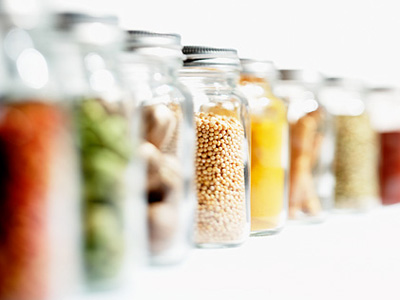
A few weeks ago I wrote a blog post on stocking a healthy fridge for spring cleaning. Part 2 focuses on stocking a healthy pantry giving you the tools you need to make positive changes. Set your Spotify to your favourite playlist and get ready to clean out that pantry and ditch the junk!
Step 1: Start by going through your non-perishable foods. Check best-before dates on all items (canned goods, breakfast cereals, crackers, nut butter, condiments, etc) and throw out anything past its due date. ***Best-before dates simply imply peak quality not safety, however the flavour might be off. Open all your bottles of cooking oils and if they smell throw them out. Oil should be stored in the pantry in a dark coloured glass bottle to help prevent rancidity.
There are some must-have foods for a nutrient-filled pantry. Here is a list of the staples you would find if you opened my (tiny) pantry cupboards. In addition, there are tips on proper storage to maintain peak nutrition and freshness.
.
- Cooking oils: Good quality extra virgin olive oil for salad dressing, organic coconut oil for baking and pan-frying, and sesame oil for Asian style dressing and stir-fries. Opened bottles will keep for three months
- Vinegars: Great for making homemade salad dressings and marinades for meat. My favourites are balsamic, apple cider, raspberry and rice vinegars. Opened bottles will keep for 12 months.
- Nut and seed butters: Raw almond butter, organic sunflower seed butter and tahini are staples for vegetable and fruit dips, adding to smoothies or making homemade hummus. I keep my jars in the fridge once opened. Look for brands that contain no added sugars or oils.
- Canned goods: I purchase most of these from Costco or No Frills for their low cost. To avoid BPA added to the tin lining, you can buy individual organic cans at grocery stores but the cost will be much higher. My pantry staples include: diced tomatoes, beans (black beans, chickpeas, kidney beans), low-sodium vegetable and chicken broths, light tuna (lower mercury content than white), wild Alaskan salmon, artichoke hearts packed in water, and organic salsa (Neil Brother’s is my favourite brand!)
- Dried fruit: I limit the amount of dried fruit I consume because of their high sugar content and typically only use them as a sweetener in baked goodies and desserts. Medjool dates from Costco are the perfect base for many paleo desserts options, and PC organic Thompson raisins are delicious in homemade granola bars or as an addition to quinoa salad.
- Breakfast cereals: I don’t often have breakfast cereals in my pantry because I find most gluten-free cereals tastes awful or are full of sugar. Instead I purchase certified GF oats and use them in homemade granola bars, overnight oats and chia pudding, or grind them for oat flour when baking.
- Whole grains: I always have a giant bag of organic quinoa from Costco which serves as a base for curries and stews instead of rice or as a salad in the summer.
- Dried herbs and spices: Dried herbs and spices add a lot of flavour without any additional sugar or fat. Avoid pre made spice mixes that often contains huge amounts of sugar, added preservatives and/or artificial flavours. My favourite spices include ginger, cinnamon, nutmeg, allspice, curry powder, cumin, basil, oregano, dill, chili powder, paprika and rosemary.
Step 2: Just Toss It
The biggest obstacle to maintaining a healthy diet is processed foods that are high in sugar, saturated fat, artificial flavours and colours that provide very little nutrition or fibre.
- Fat-free Salad Dressing: If the label says fat-free think chemical and sugar overload. Plus you need fat to absorb many important vitamins and antioxidants. Steer clear or these or make your own at home.
- Fruit Juice: Fruit juice is equivalent to soft drinks in my opinion, nothing more than simple sugars that cause a huge sugar spike in your blood followed by a crash. Avoid juice of any form and drink water flavoured with fresh lemon or cucumber instead.
- Artificial sweeteners: Aspartame, Sucralose and saccharin have been shown to alter gut bacteria, which may inadvertently lead to unintended weight gain and only raise your sugar cravings. Avoid purchasing diet soft drinks, 0% yogurt, and protein bars sweetened with artificial sweeteners.
- Packaged foods: Boxed granola bars, chips, sugary breakfast, instant noodles, dried fruit snacks, candy and store-made pastries and muffins are probably some of the worst foods you can consume. They contain nothing but refined carbohydrates and no real nutrients, vitamins, minerals or fibre. Make your own granola bars or muffins in big batches and freeze them. Plan ahead by packing healthy snacks such as fresh fruit, raw nuts or hard-cooked eggs for travel.
Looking for more great tips including meal planning, portion sizes and recipes ideas? Book an appointment with me and start living your healthier life today!

